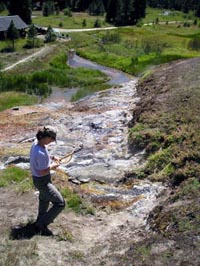Fault Hydrology
 |
How many features can you think of that connect the surface of the Earth to the upper Mantle? That can shake buildings in Los Angeles, or host a gold deposit in
Australia? What aspect of geology plays a critical role in petroleum resource recovery, geothermal energy, mining, economics and tourism, and safe disposal of nuclear waste?
If you answered "faults" to the above questions, you're correct! Faulting is arguably the most universally applicable area of the Earth Sciences, and the study of fluid flow in faults is one of the strongest research areas of the Computational Hydrology Group. Building on our expertise in geospatial analysis, modeling, and non-invasive field characterization, we have played a leading role in the study of subsurface fluid flow in active faults. Field-scale descriptions of fault architecture and hydraulic properties developed by our group have applications in many areas of environmental and economic importance. For more information on the CHG's research in fault hydrology, look over the papers in our list of publications, or email Dr. Jerry Fairley at jfairley@uidaho.edu. |







